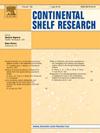食入猎物会加剧地中海商业鱼类的微塑料负荷
IF 2.2
3区 地球科学
Q2 OCEANOGRAPHY
引用次数: 0
摘要
我们描述了来自西地中海(Fiumicino, Italy)的四种可食用鱼类对塑料的摄入:Micromesistius poutassou, Mullus barbatus, Sardina pilchardus和Trachurus Trachurus。小于1毫米的微粒,特别是由玻璃纸制成的蓝色纤维,在大小、颜色、形状和聚合物方面都是最常见的。污染程度最高的是沙丁鱼和所有物种的猎物胃。我们从与商业相关的鱼类中收集了证据,其中两种可以作为微塑料的良好生物指标(barbatus和T. trachurus),另一种研究较少(M. poutassou),以有助于对mp引起的地中海生态系统和人类活动风险的总体评估。本文章由计算机程序翻译,如有差异,请以英文原文为准。
Ingestion of prey intensifies microplastic load in Mediterranean commercial fish
We describe the ingestion of plastics by four edible fish species from the Western Mediterranean Sea (Fiumicino, Italy): Micromesistius poutassou, Mullus barbatus, Sardina pilchardus, and Trachurus trachurus. Microparticles smaller than 1 mm, particularly blue fibres made of cellophane, are the most found in terms of size, colour, shape, and polymer. The highest level of contamination was found in Sardina pilchardus and in stomachs containing prey across all species. We have gathered evidence from commercially relevant fishes, of which two can be good bioindicators of microplastics (M. barbatus and T. trachurus), and one is poorly investigated (M. poutassou) in order to contribute to the overall assessments of the MP-induced risks for the Mediterranean ecosystem and human activity.
求助全文
通过发布文献求助,成功后即可免费获取论文全文。
去求助
来源期刊

Continental Shelf Research
地学-海洋学
CiteScore
4.30
自引率
4.30%
发文量
136
审稿时长
6.1 months
期刊介绍:
Continental Shelf Research publishes articles dealing with the biological, chemical, geological and physical oceanography of the shallow marine environment, from coastal and estuarine waters out to the shelf break. The continental shelf is a critical environment within the land-ocean continuum, and many processes, functions and problems in the continental shelf are driven by terrestrial inputs transported through the rivers and estuaries to the coastal and continental shelf areas. Manuscripts that deal with these topics must make a clear link to the continental shelf. Examples of research areas include:
Physical sedimentology and geomorphology
Geochemistry of the coastal ocean (inorganic and organic)
Marine environment and anthropogenic effects
Interaction of physical dynamics with natural and manmade shoreline features
Benthic, phytoplankton and zooplankton ecology
Coastal water and sediment quality, and ecosystem health
Benthic-pelagic coupling (physical and biogeochemical)
Interactions between physical dynamics (waves, currents, mixing, etc.) and biogeochemical cycles
Estuarine, coastal and shelf sea modelling and process studies.
 求助内容:
求助内容: 应助结果提醒方式:
应助结果提醒方式:


